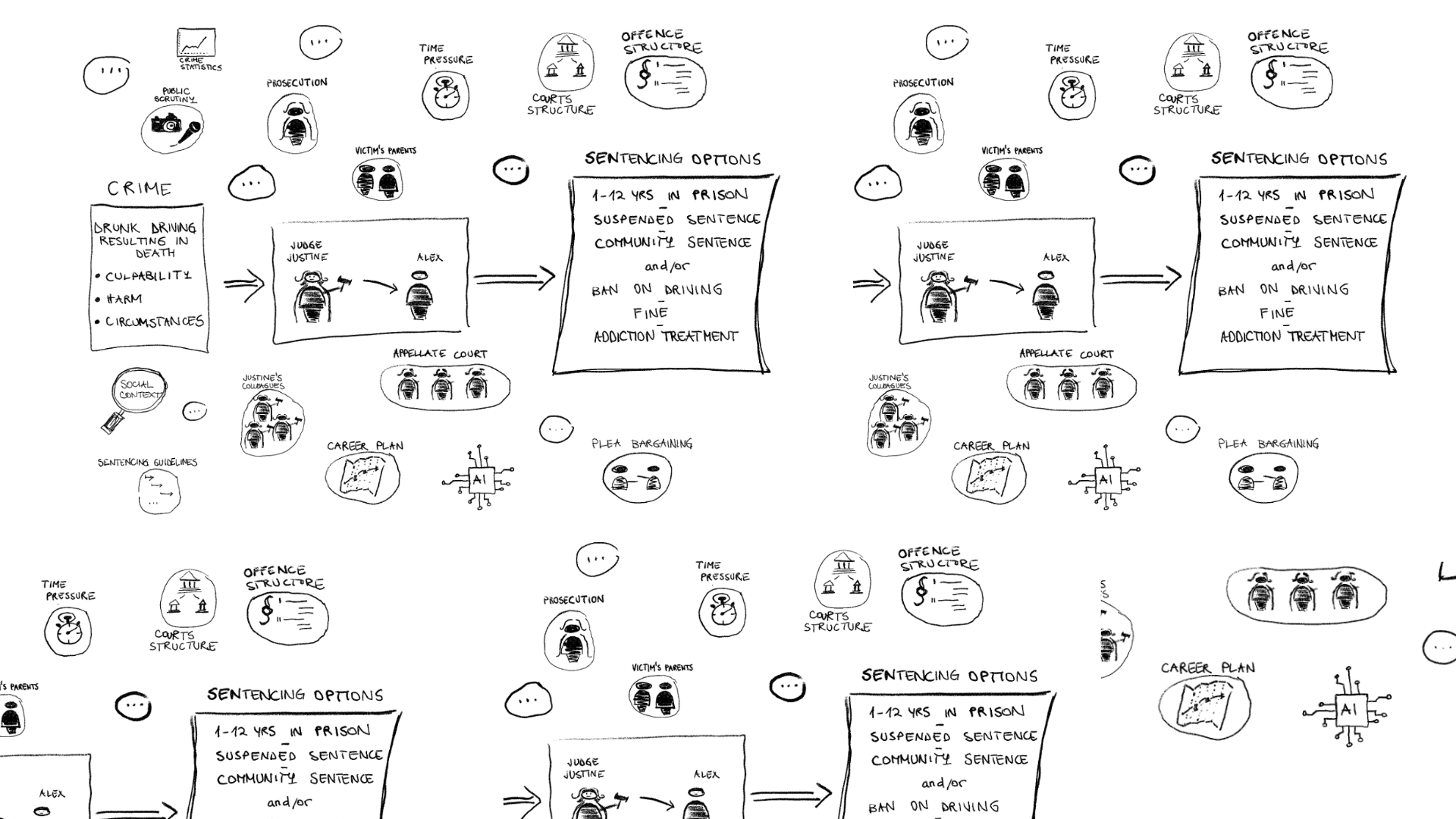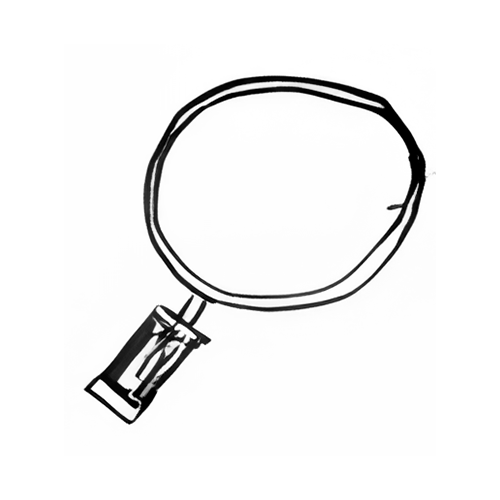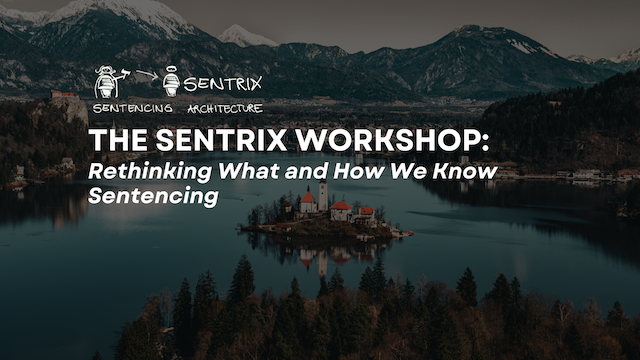In November 2025, sentencing scholars from across Europe and beyond will gather by the shores of Lake Bled for something slightly different: a workshop that is part conversation, part experiment, and part reflection on how we know what we know.
The Sentrix Workshop is designed as a laboratory for ideas. Rather than a conference of finished papers, it is a carefully structured space for discovery, where we observe, discuss, and refine how sentencing knowledge is produced, shared, and reshaped when great minds think together.
Why This Format
At Sentrix, we see sentencing not as a single act of legal judgment, but as a complex decision environment: shaped by institutions, cognition, emotion, and social expectations. To study it properly, we need formats that mirror this complexity. This is why the workshop doubles as both a forum for dialogue and a research instrument: every conversation, activity, and pause is designed to spark new thinking and to help us capture how scholars describe, combine, and interpret the elements that make up the sentencing world.
The Research Refinery: Where It Begins
The first part of the workshop, the Research Refinery, is our smallest and most intimate component: a morning dedicated to early-career researchers and PhD students working on sentencing and criminal justice.
Here, they will bring their projects, questions, and dilemmas to the table and refine them through collective feedback. Senior scholars will act not as formal discussants, but as co-thinkers: asking questions, offering strategic advice, and helping participants locate their projects within the wider sentencing landscape. The goal isn’t to critique, but to sharpen and help emerging researchers clarify what they want to contribute and how. This is why we call it a refinery: it, hopefully, turns promising raw material into something clearer, more focused, and ready to enter the next stage of research.
Moreover, the refinery is where the flow of the workshop starts: a microcosm of how ideas evolve when curiosity meets experience. It is meant to set the tone: reflective, collaborative, and open-ended.
The Workshop: Opening, Digging, Reimagining

After the refinery, the full workshop unfolds through a series of carefully curated thematic sessions, each examining a different layer of sentencing:
Opening the Map: How We Think About Sentencing
We begin by collectively mapping the field; tracing the conceptual and disciplinary lines that define “sentencing research” and thinking about “what could be”. How do different disciplines (e.g. law, criminology, psychology, sociology) approach sentencing? What do they emphasise, and what do they overlook? We start by tracing our conceptual geography: where we stand, what we see, and where we might go next.
Beneath the Robe: What Shapes Judicial Reasoning?
We then move inward, exploring what drives judicial reasoning: emotion, intuition, institutional norms, and experience. What lies behind the formal justifications judges give? How do human factors shape legal decisions? This session probes the cognitive and emotional undercurrents that shape sentencing practice.
Distorted Mirrors: Inequality in Sentencing Practice
Next, we look outward – at the many ways sentencing is reflected, interpreted, and misinterpreted in media, politics, and public debate. What happens when sentencing becomes a symbol, a statistic, or a scandal? Participants will examine the multiple ways in which gender, ethnicity, class, and social capital influence judicial reasoning and sentencing outcomes.
At the Edges: Decision-Making Beyond the Courtroom
And then we move outward, to the system’s peripheries, to the processes we do not intuitively or immediately connect to sentencing. What happens when sentencing logic extends into probation, parole, restorative justice, or algorithmic assessment – and vice versa? Perhaps, at the edges, the architecture of discretion becomes more visible and also more troublesome.
Between the Lines: Institutions, Roles, and Interactions
Next, we dive into the subtler architecture of sentencing: the “lines” that organise institutional life: forms, roles, habits, and scripts. How do small procedural designs and expectations nudge behaviour? How do roles and routines structure who gets heard? This session aims to decode the everyday design of justice that we most often take for granted.
Redesigning the Blueprint: Guiding, Nudging, Reforming
We then turn from diagnosis to design. If sentencing is an architecture, how might we re-imagine it? What would it mean to guide or “nudge” decision-making toward fairness, transparency, and care, all without undermining judicial independence? In this session, scholars will experiment with conceptual and institutional redesigns, imagining systems that make decision-making more transparent, fair, and human.
Enter AI: What Do We Need to Talk About?
Finally, we open to the future. How will AI, machine learning, and data analytics reshape sentencing research and sentencing itself? We discuss what we can responsibly do with computational tools, and, perhaps, what we should not. The goal is not technological evangelism, but critical dialogue: identifying what kind of AI conversation sentencing actually needs.
Designing for Discovery
Even the informal parts of the Bled programme are designed with intent. Moments of pause, such as a walk around the lake, a shared meal, a change of setting, are not simply breaks, but opportunities to think differently. By stepping outside the working space, participants can shift perspective and notice new patterns: how ideas move, connect, or take on new meaning when seen from another angle.
These moments help us explore what happens when sentencing itself is put “in motion”: when we loosen the boundaries of formal discussion and allow reflection, emotion, and intuition to surface. Through this rhythm of engagement and pause, we hope to capture other ways of knowing, insights that emerge not in the structure of sessions, but in the spaces between them.
The Data-Gathering Dimension

Throughout the workshop, we will be observing and documenting how scholars describe sentencing: what elements they see as central, how they relate and interact, and how disciplinary perspectives shape what is noticed or valued. Through short reflections, notes, and conversations, we aim to build a picture of how experts understand sentencing: its moving parts, its tensions, its logics – as articulated by those who study and shape it.
This will form part of a broader Sentrix effort: to create a dynamic, data-driven map of sentencing research that shows how ideas, disciplines, and questions connect across the field.
From Bled to the Broader Map
What happens in Bled will not stay in Bled.
The reflections, interactions, and emergent ideas from the workshop will feed directly into the next Sentrix phase: building a data-driven, interactive map of sentencing knowledge. In this sense, the workshop is both an intellectual gathering and the foundation of something larger: an evolving representation of how sentencing is thought about and understood, collectively.
The Sentrix Workshop at Bled is, above all, a conversation with the field itself. It is an opportunity to learn what sentencing is from those who have spent their careers exploring its depths, and to capture how their ideas connect, collide, and create new understanding.






